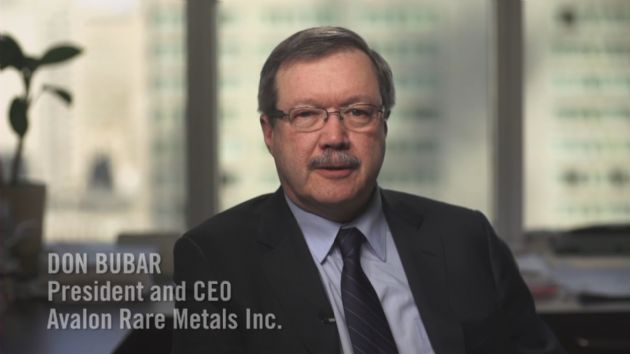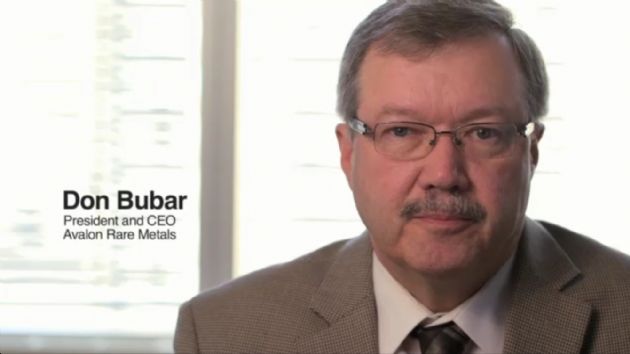 Avalon Rare Metals (TSE:AVL) Confirms Significantly Improved Economics for the Nechalacho Rare Earth Elements Deposit, Thor Lake NWT, Canada
Avalon Rare Metals (TSE:AVL) Confirms Significantly Improved Economics for the Nechalacho Rare Earth Elements Deposit, Thor Lake NWT, Canada
Toronto, July 8, 2011 AEST (ABN Newswire) - Avalon Rare Metals ( TSE:AVL) (
TSE:AVL) ( NYSE:AVL) is pleased to announce a significant improvement in the anticipated economics of the Nechalacho Rare Earth Elements ("REE") deposit at Thor Lake NWT, Canada (the "Project"), based on the results of an update of its June, 2010 Prefeasibility Study ("PFS"). The update was prepared to reflect a new mine plan based on an update of the Mineral Reserve Estimate which was, in turn, based on the Company's January, 2011 mineral resource update as well as higher product prices.
NYSE:AVL) is pleased to announce a significant improvement in the anticipated economics of the Nechalacho Rare Earth Elements ("REE") deposit at Thor Lake NWT, Canada (the "Project"), based on the results of an update of its June, 2010 Prefeasibility Study ("PFS"). The update was prepared to reflect a new mine plan based on an update of the Mineral Reserve Estimate which was, in turn, based on the Company's January, 2011 mineral resource update as well as higher product prices.
The updated PFS produced a discounted cash flow ("DCF") analysis yielding a 39% Internal Rate of Return ("IRR") on a pre-tax basis (compared to 14% in the original study) and a 34% IRR on an after-tax basis (compared to 12% in the original study). The NPV at a 10% discount rate is now CAD$1.77 billion pre-tax and CAD $1.27 billion after-tax.
Don Bubar, President and CEO states, "While higher levels of profitability based on a higher price assumption was not an unexpected result, a significant part of the improved economics arises from the higher grade heavy rare earth subzones discovered in 2010, which result in substantially increased revenues during the early years of production. Furthermore, we continue to use a relatively conservative price assumption for rare earth oxides relative to current prices, on the expectation that prices will ultimately decrease from current record levels as new supply comes into the market. Interestingly, if one applies current prices in our model, it generates an impressive 102% IRR pre-tax and 89% IRR after-tax. The NPV at a 10% discount rate would be CAD$7.65 billion pre-tax and CAD $5.59 billion after-tax.
Summary of Financial Analysis
The current study is an update to the original prefeasibility study prepared by independent consultants Roscoe Postle Associates Inc. ("RPA"), and disclosed in the news release dated June 21, 2010. The updated PFS is based principally on an updated Mineral Reserve estimate that was derived from a new mine plan developed from the updated mineral resource estimate disclosed in January, 2011. In addition to higher product price assumptions, the new economic analysis also incorporates related updates to operating costs, foreign exchange rates and production ramp-up time-lines as summarized below (see link at the bottom of the release).
The updated PFS (like the original PFS) does not include a refinery/separation plant in the development model and revenues for rare earth oxides are discounted accordingly to account for the cost for separation. Construction of a separation plant and refinery will be included in the development model for the Bankable Feasibility Study to be completed in late 2012. Only a scoping level analysis of costs associated with a separation plant are presently available (see news release dated October 21, 2010) and therefore could not be included in the updated PFS. Work on a Prefeasibility Study for a separation plant is underway and is targeted for completion in early 2012. Significant differences in the parameters between the updated PFS and the original PFS are summarized as follows (not all inclusive):
The 20 year mine life is based on a new CIM-compliant Probable Mineral Reserve estimate of 14.5 million tonnes of 1.53% TREO, 2.90% zirconium oxide (ZrO2), 0.38% niobium oxide (Nb2O5) and 0.04% tantalum oxide (Ta2O5). The mining method was updated to include some long-hole stoping in the thicker parts of the reserve, but no changes were made to the metallurgical process flowsheets from the original PFS, where combined recoveries of TREO, ZrO2, Nb2O5 and Ta2O5 are 84.6% from the flotation plant and 90% from the hydrometallurgical plant. All four products are concentrated together and are only isolated into individual products in the final stages of the hydrometallurgical process and therefore, their recovery costs have been aggregated.
The financial model assumes 100% equity financing, although the Company plans to pursue various financing options including debt, upon completion of the bankable feasibility study. Financial analyses prepared for pre-feasibility studies are designed to determine if, after applying conservative assumptions on costs and revenues, the project stands up as an economically viable development opportunity. In this regard, management is pleased that the DCF for the updated PFS again yielded positive results that are considerably more robust than the results of the DCF analysis produced in the original PFS. Sensitivity analyses demonstrate that profitability is most sensitive to total revenue, exchange rate, operating costs and the metals prices.
The complete report will be posted on SEDAR no later than August 21, 2011.
Resources and Reserves
An updated Indicated and Inferred Mineral Resource estimate was prepared by Avalon and disclosed in the Company's news release dated January 27, 2011. The complete summary table of resources from this release (including individual rare earth oxide concentrations) is reproduced below (see link at the bottom of the release) for convenience, but the reader is referred to the January 27, 2011 news release and the subsequent NI 43-101 report for complete disclosure of the resource estimation methodology employed and other relevant context.
The Indicated Mineral Resources that form the basis of the Probable Mineral Reserves below (see link at the bottom of the release) total 57.486 million tonnes of 1.56% TREO and 0.33% HREO, with 20.72% HREO/TREO. Concentrations for all of the individual rare earth oxides and the by-product rare metals are provided below (see link at the bottom of the release).
The Indicated Mineral Resources for only the Basal Zone at various Net Metal Return (NMR) cut-offs are summarized below (see link at the bottom of the release). While the $260 NMR cut-off continues to be the base case, the table below (see link at the bottom of the release) highlights the presence of significant tonnages in higher grade sub-zones recognizable by applying a higher NMR cut-off. A portion of these higher grade sub-zones was included in the mine development plan.
Probable Mineral Reserves were estimated by Avalon and audited by RPA, as summarized below (see link at the bottom of the release). The Probable Mineral Reserves represent that portion of the Indicated Resources in the Basal Zone that are included in the Mine Development Plan. Future additions to the Probable Mineral Reserves are likely once all the detailed definition drilling being conducted in 2011 is incorporated into the resource model.
Note: Details of individual REE grades in the Probable Mineral Reserves along with a plan of the reserves and other relevant information are posted on our website. The grades for the individual REE closely reflect those in the Indicated Resources table provided above.
Rare Metals Markets and Prices
Like the original PFS, the updated PFS assumes that Avalon will be selling a mixed rare earth oxide concentrate at a price derived using a model that discounts future individual oxide prices (by an average of 38%) to reflect the semi processed nature of the concentrate. In fact, Avalon now contemplates establishing its own separation and refining facility in North America, but has not yet completed a prefeasibility study on this facility to allow it to be incorporated into the present updated PFS. Work on this prefeasibility study has been initiated under a new contract with the same consultant that completed the scoping study in 2010.
The average "basket" price calculated for the Nechalacho mixed rare earth concentrate and used in the original PFS was US$21.94/kg. The average "basket" price for the Nechalacho mixed rare earth concentrate using the updated price forecast for 2015 is US$ 46.33/kg.
The updated PFS bases the REE price assumption on a price forecast published by CIBC World Markets in its Rare Earth Industry Overview dated March 6, 2011, (except for the elements Ho, Er and Lu for which the original PFS price forecast was used). The table below (see link at the bottom of the release) provides a comparison of the price forecasts used for each rare earth oxide in the original vs. the updated PFS.
As discussed in Avalon's Industry Bulletin dated June 13, 2011, current prices FOB China reported by services such as Metal-pages.com, are much higher than those used in the price forecast for the updated PFS, reflecting the opinion of both RPA and the Company that future prices are likely to decrease from current record levels as new supply comes into the marketplace. This is particularly true of the light rare earths which are expected to comprise most of the new supply anticipated over the next 2-3 years. Heavy rare earth prices, particularly for terbium, dysprosium and europium, may remain high as little new supply is expected to come into the marketplace until Avalon commences production at Nechalacho in 2015. Interestingly, if one applies current FOB China prices to the Nechalacho mixed rare earth concentrate, a basket price of US$153.83/kg can be calculated.
Avalon's market share of total rare earth demand is conservatively forecast to be less than 5% at a 10,000 tonnes/year TREO production rate. Initial market share for certain more valuable individual HREE, such as dysprosium and terbium, is estimated at 8% and 6% respectively. On this basis, estimated production volumes for individual rare earths are provided in the table. However, the large size of the resource could likely support a higher production rate in the event that market demand ultimately exceeds current forecasts.
The Nechalacho deposit contains a number of other rare metals, notably, niobium, zirconium and tantalum that will also be recovered as valuable by-products. Gallium may also be recovered at a later stage. At the prices assumed for this PFS, the rare earths represent 69% of the anticipated total project revenues while niobium, zirconium and tantalum represent 31%. Niobium represents 15% and zirconium makes up 12% and tantalum represents 4% of total project revenues.
Since niobium is widely used in the steel industry, the niobium pentoxide price assumption of US$55.86 per kilogram is based on a representative current price escalated for inflation and for the expected increase in steel demand. The price of US$255.63 per kilogram for tantalum oxide is based on a representative current price, escalated for inflation. The price assumption of US$3.77 per kilogram for zirconium oxide is unchanged from the original PFS, reflecting less certainty about future supply demand balance in zirconium products. Avalon continues to have strong interest in off-take for its niobium, tantalum and zirconium products.
The annual metal production forecast in the updated PFS (expressed as oxides) is given in the table below (see link at the bottom of the release). Year 1 is less than typical as it is only a partial year to allow for initial production ramp-up.
Qualified Persons
Jason Cox P.Eng., Director of Mine Engineering, Tudor Ciuculescu P.Geo. (Ontario) Geologist, and Don Hains P.Geo. (Ontario) of RPA, and J.R. Goode, P.Eng, Consulting Metallurgist, are Qualified Persons as defined by National Instrument 43-101 and have verified that the technical information in this news release accurately reflects the technical information in the PFS.
For the complete Avalon Rare Metals Inc. announcement including figures and tables, please refer to the following link:
http://www.abnnewswire.net/media/en/docs/68293-tn.jsp.pdf
About Avalon Advanced Materials Inc
 Avalon Advanced Materials Inc. (TSE:AVL) (OTCMKTS:AVLNF) (formerly Avalon Rare Metals) is a Canadian mineral development company specializing in niche market metals and minerals with growing demand in new technology. The Company has three advanced stage projects, all 100%-owned, providing investors with exposure to lithium, tin and indium, as well as rare earth elements, tantalum, niobium, and zirconium. Avalon is currently focusing on its Separation Rapids Lithium Project, Kenora, ON and its East Kemptville Tin-Indium Project, Yarmouth, NS. Social responsibility and environmental stewardship are corporate cornerstones.
Avalon Advanced Materials Inc. (TSE:AVL) (OTCMKTS:AVLNF) (formerly Avalon Rare Metals) is a Canadian mineral development company specializing in niche market metals and minerals with growing demand in new technology. The Company has three advanced stage projects, all 100%-owned, providing investors with exposure to lithium, tin and indium, as well as rare earth elements, tantalum, niobium, and zirconium. Avalon is currently focusing on its Separation Rapids Lithium Project, Kenora, ON and its East Kemptville Tin-Indium Project, Yarmouth, NS. Social responsibility and environmental stewardship are corporate cornerstones.




![abnnewswire.com]()
Related Companies
Social Media
Share this Article

 TSE:AVL) (
TSE:AVL) ( NYSE:AVL) is pleased to announce a significant improvement in the anticipated economics of the Nechalacho Rare Earth Elements ("REE") deposit at Thor Lake NWT, Canada (the "Project"), based on the results of an update of its June, 2010 Prefeasibility Study ("PFS"). The update was prepared to reflect a new mine plan based on an update of the Mineral Reserve Estimate which was, in turn, based on the Company's January, 2011 mineral resource update as well as higher product prices.
NYSE:AVL) is pleased to announce a significant improvement in the anticipated economics of the Nechalacho Rare Earth Elements ("REE") deposit at Thor Lake NWT, Canada (the "Project"), based on the results of an update of its June, 2010 Prefeasibility Study ("PFS"). The update was prepared to reflect a new mine plan based on an update of the Mineral Reserve Estimate which was, in turn, based on the Company's January, 2011 mineral resource update as well as higher product prices. Avalon Advanced Materials Inc. (TSE:AVL) (OTCMKTS:AVLNF) (formerly Avalon Rare Metals) is a Canadian mineral development company specializing in niche market metals and minerals with growing demand in new technology. The Company has three advanced stage projects, all 100%-owned, providing investors with exposure to lithium, tin and indium, as well as rare earth elements, tantalum, niobium, and zirconium. Avalon is currently focusing on its Separation Rapids Lithium Project, Kenora, ON and its East Kemptville Tin-Indium Project, Yarmouth, NS. Social responsibility and environmental stewardship are corporate cornerstones.
Avalon Advanced Materials Inc. (TSE:AVL) (OTCMKTS:AVLNF) (formerly Avalon Rare Metals) is a Canadian mineral development company specializing in niche market metals and minerals with growing demand in new technology. The Company has three advanced stage projects, all 100%-owned, providing investors with exposure to lithium, tin and indium, as well as rare earth elements, tantalum, niobium, and zirconium. Avalon is currently focusing on its Separation Rapids Lithium Project, Kenora, ON and its East Kemptville Tin-Indium Project, Yarmouth, NS. Social responsibility and environmental stewardship are corporate cornerstones.








